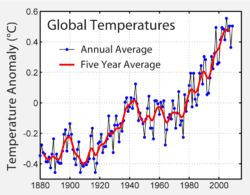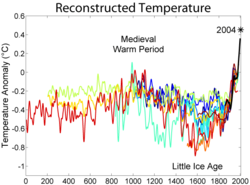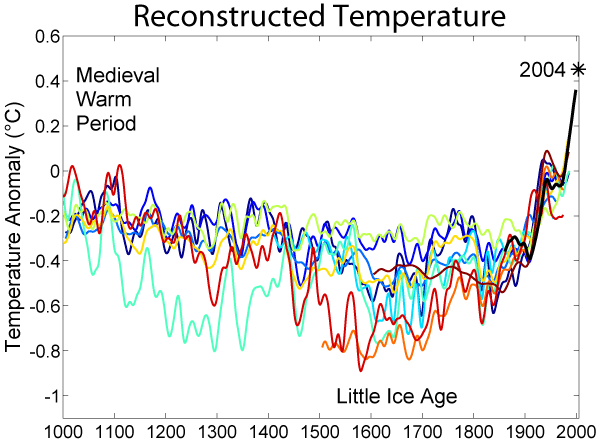
File:1000 Year Temperature Comparison.png
| |
This is a file from the Wikimedia Commons. Information from its description page there is shown below.
Commons is a freely licensed media file repository. You can help. |
Contents |
Summary


This image is a comparison of 10 different published reconstructions of mean temperature changes during the 2nd millennium. More recent reconstructions are plotted towards the front and in redder colors, older reconstructions appear towards the back and in bluer colors. An instrumental history of temperature is also shown in black. The medieval warm period and little ice age are labeled at roughly the times when they are historically believed to occur, though it is still disputed whether these were truly global or only regional events. The single, unsmoothed annual value for 2004 is also shown for comparison. ( Image:Instrumental Temperature Record.png shows how 2004 relates to other recent years).
It is unknown which, if any, of these reconstructions is an accurate representation of climate history; however, these curves are a fair representation of the range of results appearing in the published scientific literature. Hence, it is likely that such reconstructions, accurate or not, will play a significant role in the ongoing discussions of global climate change and global warming.
For each reconstruction, the raw data has been decadally smoothed with a σ = 5 yr Gaussian weighted moving average. Also, each reconstruction was adjusted so that its mean matched the mean of the instrumental record during the period of overlap. The variance (i.e. the scale of fluctuations) was not adjusted (except in one case noted below).
Except as noted below, all original data for this comparison comes from and links therein. It should also be noted that many reconstructions of past climate report substantial error bars, which are not represented on this figure.
 |
This graph image could be recreated using vector graphics as an SVG file. This has several advantages; see Commons:Media for cleanup for more information. If an SVG form of this image is already available, please upload it. After uploading an SVG, replace this template with {{ vector version available|new image name.svg}}. |
This information is accurate, however if you are looking for a time before 1000 A.D. it does not depict a length of time before 1000 years when the earth used to be all tropical. It fails to convey the whole story.
Reconstructions
The reconstructions used, in order from oldest to most recent publication are:
- (dark blue 1000-1991): The Holocene.
- (blue 1000-1980): Geophysical Research Letters.
- (light blue 1000-1965): Ambio. Modified as published in Science.
- (lightest blue 1402-1960): J. Geophys. Res..
- (light green 831-1992): Science.
- (yellow 200-1980): Geophysical Research Letters. doi: 10.1029/2003GL017814.
- (orange 200-1995): Reviews of Geophysics. doi: 10.1029/2003RG000143
- (red-orange 1500-1980): Geophys. Res Lett.. doi: 10.1029/2004GL019781
- (red 1-1979): Nature. doi: 10.1038/nature03265
- (dark red 1600-1990): Science. doi: 10.1126/science.1107046
(black 1856-2004): Instrumental data was jointly compiled by the Climatic Research Unit and the UK Meteorological Office Hadley Centre. Global Annual Average data set TaveGL2v was used.
Documentation for the most recent update of the CRU/Hadley instrumental data set appears in: Journal of Climate.
Copyright
The original version of this figure was prepared by Robert A. Rohde from publicly available data and is incorporated into the Global Warming Art project.
 |
Permission is granted to copy, distribute and/or modify this document under the terms of the GNU Free Documentation License, Version 1.2 or any later version published by the Free Software Foundation; with no Invariant Sections, no Front-Cover Texts, and no Back-Cover Texts. A copy of the license is included in the section entitled GNU Free Documentation License. http://www.gnu.org/copyleft/fdl.htmlGFDLGNU Free Documentation Licensetruetrue |
| This file is licensed under the Creative Commons Attribution-Share Alike 3.0 Unported license. | ||
|
||
| This licensing tag was added to this file as part of the GFDL licensing update.http://creativecommons.org/licenses/by-sa/3.0/CC-BY-SA-3.0Creative Commons Attribution-Share Alike 3.0 truetrue |
Notes
- Data from Moberg et al. was taken directly from the supplemental information accompanying the Nature article.
- Data for Oerlemans was provided by William M. Connolley.
- Esper et al. reported only fluctuations in "arbitrary" units, so the variance in this record was rescaled to match the variance during the period of overlap with the instrumental record.
- When a paper included multiple reconstructions, the global annually average temperature data was used. If this was not reported, then Northern Hemisphere annually averaged data was used.
- Four records appearing at were not used in preparing this graph for the following reasons:
- Mann et al. 98 was not included because Mann et al. 99 extended and updated that record.
- Briffa et al. 98 was not included because Briffa et al. 2001 extended and updated that record.
- Pollack et al. 98 was not included because the reported data was not found to be in a form that allowed for easy replotting.
- Mann et al. 2000 was not used because it did not include an original reconstruction covering at least the Northern Hemisphere.
| Dragons flight's Temperature Record Series |
| This figure is part of series of plots created by Dragons flight to illustrate changes in Earth's temperature and climate across many different time scales. |
| Time Period: 25 yrs | 150 yrs | 1 kyr | 2 kyr | 12 kyr | 450 kyr | 5 Myr | 65 Myr | 500 Myr |
| For articles related to this topic see: Temperature record |
File usage
Metadata
| Software used |
|
|---|
What is Schools Wikipedia?
Wikipedia for Schools was collected by SOS Children. By supporting vulnerable children right through to adulthood, SOS Children makes a lasting difference to the lives of thousands of people. Education is a key part of our work, and our schools provide high-quality teaching to the children in our care. There are many ways to help with SOS Children.

